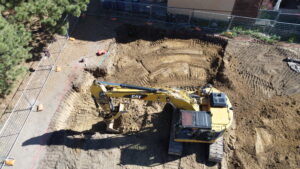In a previous post, I discussed the sources of short- and long-term losses in unbonded post-tension tendons. Recently, a question came up on one of my LinkedIn groups regarding elastic shortening and sequential stressing.

To refresh your minds, concrete — which is generally regarded by non-engineers as totally inflexible — is actually elastic at the forces and scales that art typical for structural engineering. The enormous compressive forces exerted by post-tension tendons must be carefully considered when laying out formwork, designing shearwalls, and the tendons themselves.
An ASTM Grade 270, 1/2″ nominal 7-wire prestressing strand (the type most commonly used for unbonded post-tension projects in the United States) has a code-maximum stress immediately after jacking of just over 30,000 pounds. For perspective, that’s 5 “basic” HMMVWs, or 7 pickup trucks. On all but the smallest projects, those tendons are typically tied in bundles of 2 to 5. On the types of projects I design, those tendons are stressed individually.
The individual stressing is the rub. When we stress a single tendon, the elastic shortening of the slab is part and parcel with the jacking and anchor set. When we stress the next tendon in the series, the slab gets shorter — again — but the first tendon has already been locked off, so we lose a small fraction of the force that tendon was holding. The third tendon makes the slab still shorter, so the second tendon loses some force, and the first tendon loses even more.
Accounting for these losses is one of the many factors that go into the final package for a post-tension design. Our combined-discipline team is expert at bringing these components together — let us know how we can help on your next project.










